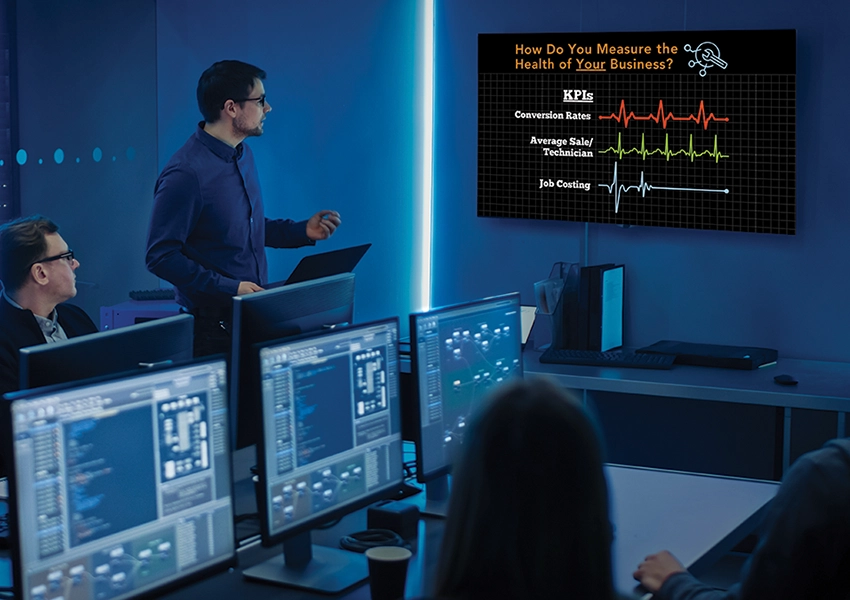You have good Google reviews and a few positive mentions on Yelp. Is that enough? No, particularly if the reviews were solicited from a handful of your best customers and acquaintances. You need better information that allows you to quantify customer satisfaction levels, what drives them, and how to adjust your business to improve them. An HVAC contracting business is a service business, which means it will thrive or die based on the experiences it creates in customers' minds. So, measuring how satisfied your customers are over time is crucial to ensure you deliver a consistently positive service experience for continued loyalty and future referrals.
Before discussing how to measure HVAC customer satisfaction, first consider what you are trying to measure. In 2023, Chick-fil-A’s average per-store sales were more than $8 million compared to about $3.5 million for McDonald's, and their market share grew from 38% in 2022 to over 45% in 2023. All of this success has been the result of focusing squarely on creating an outstanding customer experience: from how employees greet customers to the speed of service and the quality of the food. Last year, Chick-fil-A was ranked #1 on the American Customer Satisfaction Index for the ninth year in a row. And Chick-fil-A is not the low-cost option for fast food.
Apple is another great example of an organization that has flourished by creating an unmatched customer experience. Not unlike successful HVAC dealerships, Apple has succeeded by selling products that build strong, sustainable relationships with customers. It’s not a one-and-done with Apple. The purchase of an iPhone is just the first bite off a long-term, highly profitable customer journey that seldom results in low satisfaction. This should be the model of every ambitious HVAC dealership. Like Chick-fil-A, Apple’s products are higher priced than most of their competitors.
A great customer experience in HVAC is straightforward and, for the most part, universal. During a recent research project, we talked with homeowners about what they expected from a quality HVAC dealership. The vast majority said, “easy to contact,” “comes out that day,” “has a courteous and professional staff,” “conveys a sense of trust,” “has a good reputation,” “is recommended by friends or family,” “is transparent about the job and pricing,” “does excellent work,” and “follows up after the work is done.” These variables provide an excellent foundation for measuring and assessing customer satisfaction.
But how do you go about accurately measuring customer satisfaction levels? There are many methods, with the most effective being direct phone calls from your company to customers shortly after you’ve serviced, maintained, or installed their HVAC system. Other options are leave-behind surveys that can be completed online or a follow-up email with a survey link. Create the survey with some knowledge or research into how to construct effective questionnaires. All questions should be easy to complete and structured to generate quantifiable metrics (the percentage who were extremely or very satisfied). The questions should be consistent over time to allow for tracking and trending. You will likely make slight alterations to the survey as you adjust your business, but the fundamental questions should not change.
Hiring an agency to construct, conduct and manage your customer satisfaction surveys is a great option, particularly for larger businesses or those short on resources. However, a few options allow you to manage the process in-house. If you have a Google account, they offer “Google Forms,” which can be used to create, disseminate (via email or online) and analyze surveys. “Survey Monkey” is an online software for creating and conducting surveys, but it requires a license. There are also software packages such as “Qualtrics” but cost more.
While measuring customer satisfaction is essential, you want to avoid overwhelming customers with too many questions. At a minimum, a good satisfaction survey for HVAC customers should include questions that measure overall satisfaction, likelihood to recommend the dealership to friends and family, and ratings on ease of communications and scheduling, professionalism of staff, explanation of work, price transparency, quality of work, and follow-up.
A common misconception from dealers is they know their customers so well, they don’t need a survey. We recently helped a large regional HVAC dealership in Florida implement a satisfaction survey, and to their surprise, customers were not happy with the professionalism of the staff and technicians, which caused them to give low ratings on “overall satisfaction” and “likelihood to recommend to a friend or family.” Knowing this allowed them to change their hiring and training to improve these ratings and ultimately optimize their customers’ experience. This will more than likely translate into increased sales and accelerated growth.
So, if you are simply relying on a few online reviews, it’s time to consider implementing ongoing customer satisfaction surveys to really understand what experience you are creating for customers and how to improve to grow your business. Remember that if you ask questions, you must be ready and willing to act on the responses. If your customers tell you there’s a problem, listen and respond. Whether it’s chicken, apples or HVAC, all customers want a consistently great experience.
Paul M. Berman, President & CEO of Commerce Health Business Consulting, holds an MS in Experimental Psychology from the State University of New York and an MS in Business Management from Rensselaer Polytechnic Institute (RPI). Before starting his consultancy, Paul worked in leadership roles at Carrier Corp., Johnson & Johnson, and Stryker. He specializes in providing business and marketing consulting to HVAC manufacturers, distributors, dealerships, and companies in consumer goods and health care. Contact Paul at (561) 609-5082 or www.CommerceHealthConsulting.com



